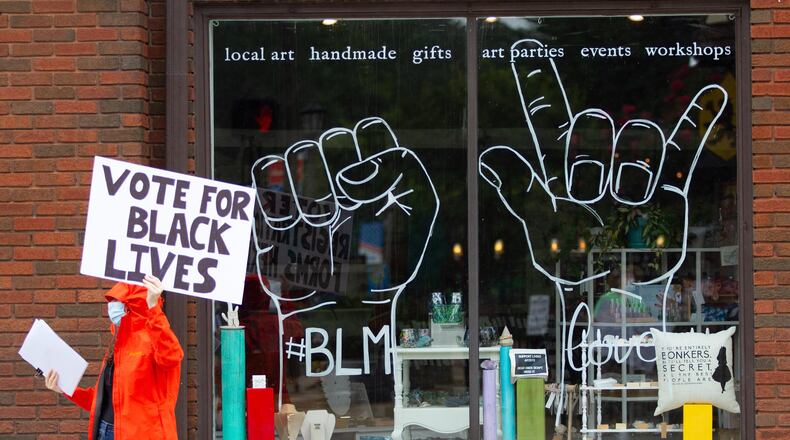Shelton Davis steps toward the edge of South Avondale Road, the side opposite the English Tudor-style shops that have stood here for nearly a century. His T-shirt reads “empathy.”
As he gets near the street, he raises his hand, extends his index and pinky fingers and sticks out his thumb.
I love you, the 40-year-old is silently telling the passing drivers.
All around him, neighbors and friends wave posters, eliciting solidarity honks from the car horns. If you want change, vote, the signs say. Black lives matter, they say.
“It’s impressive, knowing the history of this city, to be able to see this type of stuff happening here,” Davis, who describes himself as half Black, says on this recent Saturday.
The city is Avondale Estates, a small DeKalb County town that’s home to the original Waffle House, some 3,100 residents and a racist past it’s now trying to reckon with.
A former mayor once called the city “as much a tradition as it is a city,” and that’s probably true. But that tradition has meant wildly different things to different people.
Credit: Steve Schaefer
Credit: Steve Schaefer
The city was born in the 1920s, the dream of a pharmaceutical magnate who consorted with white supremacists and is at least partly responsible for the Confederate carving on the side of Stone Mountain.
George F. Willis built exclusion and racism into the very foundation of Avondale Estates, and his legacy was for decades expanded upon with local laws and rules that made generations of nearby Black residents fearful of traveling through the city, let alone trying to live there.
Today, Avondale is still predominantly white and still has a negative reputation for some. But as the city slowly begins to diversify and embarks upon its next phase — which includes luring in new development that’s vital for long-term survival — many Avondale residents and officials are pushing for a more inclusive future.
A consultant will soon be brought in to review policies and procedures at the local police department, which has a long-held reputation for being heavy handed and, to some, discriminatory. Officials have declared it their mission to make Avondale Estates more welcoming. A growing, well-organized group of residents called the Avondale Alliance for Racial Justice is holding demonstrations and keeping everyone’s feet, including their own, to the fire.
Some of it has been in the works for a while now, but much more is a reaction to the re-ignited national discussion about police shootings of Black people and systemic racism.
“Maybe there are things there that we have to face in order to move on from them,” said Kathryn Wilson, a history scholar and 12-year Avondale resident. “If we don’t look back at that, then we can’t really see ourselves.”
The ’prominent capitalist’
George Francis Willis, born in 1879 in Waynesville, North Carolina, made his original fortune hawking Tanlac, a tonic advertised as “the greatest medicine ever given to the people.” A concoction of alcohol, herbs and a few other substances, its medicinal value was, in fact, questionable at best.
But it sold.
Credit: DeKalb History Center Archives
Credit: DeKalb History Center Archives
By the early 1920s, Willis had moved to Atlanta. He’d led the very public fundraising campaign for a mass reunion of Confederate soldiers. He’d made another pharmaceutical fortune off an antiseptic called Zonite. And he’d entered the real estate game, building and buying apartment buildings in various parts of the city.
The Atlanta Constitution had labeled Willis a “prominent capitalist” even before he announced his most ambitious endeavor.
Local lore has it that Willis first eyed what was then the Ingleside community while traveling between his home in Druid Hills and Stone Mountain, where he worked with the group trying to make a Confederate carving on the mountain a reality. It’s hard to say that for sure but, regardless, Willis announced in January 1924 that he had purchased 1,000 acres in the area.
And on that farmland about seven miles east of Atlanta, Willis said, he would build the South’s very first planned community, a “model residential suburb” with new streets, new sidewalks and new, beautiful homes accented by flowers and shrubs from the city’s very own nursery. There would be a dairy and a pool and a lake, and a business district with architecture reminiscent of old England.
Avondale Estates would be a place where families could raise their children away from the grime of the city but still get there with a half-hour trolley ride — and it would be a community where, as one advertisement put it, folks could rest assured they had the “right kind of neighbors.”
Credit: DeKalb History Center Archives
Credit: DeKalb History Center Archives
In public statements and newspaper ads, Willis repeatedly pitched Avondale Estates as an exclusive community, where only “families of proven standing and financial responsibility” would be able to take advantage of its many splendors.
The Atlanta Constitution would find — some six decades later — that Willis had also attached a series of restrictive covenants to the land on which he built the city.
One of them prohibited the sale or lease of property “to any person or persons of color, or to any corporation which has as any of its officers any persons of color.”
Unlocking a park, history
Today, the gate on the far side of Willis Park has a magnetic latch but no lock. A vinyl green sign is zip-tied next to it on the head-high chain link fence, welcoming visitors with a hand-painted message: “What the world needs now is love sweet love.”
The lock on the gate — which separates both the park and the city of Avondale Estates from the adjacent neighborhood of Forrest Hills — was just removed in June. Everyone, including non-Avondale folks, now has direct access to the playground, the pavilion and the swinging iron benches.
“I think that people on the outside might see that as such a small, minor detail,” said Sarah Galatioto-Ruff, 33, one of the founders of the Avondale Alliance for Racial Justice. “But to us it’s a stepping stone, right?
The lock was added more recently, somewhere over a decade ago, amid fears of crime seeping over from a nearby apartment complex.
But, as with everything in Avondale, there was a deeper history to contend with too.
A few years before Willis died, he deeded the park and Avondale Lake to the city. Local lore had it for years that, as part of the arrangement, Willis stipulated that only Avondale residents be able to use the amenities — or his family would take them back.
Mayor Jonathan Elmore said that’s not entirely true, that the only requirement was for the city keep the park and lake well-maintained.
Credit: Steve Schaefer
Credit: Steve Schaefer
Regardless, ominous signs for years stood sentry on the periphery of both locations, warning interlopers that they were for private use only and that violators would be prosecuted. The signs made the lake in particular a frequent flashpoint, a place where police would often be called to investigate any time it looked like a non-resident — read: a non-white person — was in the area.
The signs were re-worded in 2017. Now they merely outline a few general rules and ask visitors to respect the beauty and nature of the park.
Lionel Laratte, who in 2018 became Avondale’s first Black city commissioner, is involved in a new city “welcoming committee.” He said a recent Sunday stroll around the lake put things in perspective.
There were two women there fishing with bamboo poles, he said, and south Asian and Black families enjoying nature too.
It was unclear if they lived in Avondale Estates. The city is still predominantly white, but Black and Asian residents now make up more than 10% of the population.
Then again, it didn’t really matter.
“Everyone was just hanging out,” Laratte said. “And I was like yeah, that’s the way it’s supposed to be.”
Credit: Steve Schaefer
Credit: Steve Schaefer
‘Proper restrictions’
The city of Avondale Estates was officially incorporated in 1926 and, by October 1929, George F. Willis had finished his 18-month stint as president of the Confederate monument group at Stone Mountain. Some progress on the carving had been made, but Willis’ efforts to steer it toward completion were largely unsuccessful.
Meanwhile, much of Avondale as envisioned had been built. But the Depression seemingly hit Willis — the man once “reputed to possess one of Atlanta’s largest individual fortunes” — hard.
By June of 1931, he had set up an auction to “dispose of [his] holdings” in the city. Less than a year later, creditors were suing Willis for unpaid notes.
He died in July 1932, without ever living in the city he created.
Credit: AJC ARCHIVES
Credit: AJC ARCHIVES
By 1940, somewhere just shy of 1,000 people called Avondale Estates home. About 20 of them were Black, some working as live-in help for white families and the others clustered in row houses behind the commercial district.
In the summer of 1941, the city’s Board of Mayor and Commissioners adopted a new resolution banning the sale of real estate to “persons of nationalities who do not or cannot intermarry or congenially associate with a very large majority of those now resident in Avondale Estates.”
About three months later, a newspaper ad promoting the auction of newly available Avondale lots made sure to point out that “proper restrictions” were in place.
The police question
Elizabeth Wilson — who would later lead movements to desegregate Decatur schools and libraries and, in the 1990s, become that city’s first Black mayor — moved to the area in 1949. She remembers being told two things about the small town to the east.
One: Black folks couldn’t buy homes in Avondale Estates.
And two: “African Americans don’t drive through there. Because you’ll be arrested.”
That notion, in various forms, still exists today.
In 2019, the Avondale Estates Police Department’s 14-officer staff issued 3,866 citations, its second-highest total in the last decade. The city collected over $630,000 in fines and forfeitures — more than 11% of its total annual revenue.
For many, though, it’s about a lot more than money.
Earlier this summer, City Manager Patrick Bryant said in a public meeting that around 75% of drivers cited in Avondale Estates in any given year are Black. An analysis underway by the Avondale Alliance for Racial Justice found that just 3% of the tickets issued from 2018 through March 2020 were given to actual Avondale residents.
This issue is complicated, because there’s a major highway cutting through town and most of the communities surrounding Avondale are predominantly Black. But when the police force for a chiefly white city primarily makes money from Black drivers, it is at the very least not a great look.
That’s part of the reason the AARJ and others have pushed the city to hire an outside consultant to review Avondale’s police policies and procedures, a process that’s underway.
There has been pushback, including a small counterprotest at an AARJ demonstration earlier this summer. But advocates — and officials, for that matter — are quick to clarify that they’re not anti-police; they just want to take a deeper look at things and see how everyone could be better served.
“It absolutely feeds into our long-standing reputation of being a racist, insular and unfriendly community,” said 18-year Avondale resident Patti Puckett Ghezzi, who is helping lead the traffic ticket analysis. (Ghezzi is also a former Atlanta Journal-Constitution reporter.)
Credit: Steve Schaefer
Credit: Steve Schaefer
That reputation is due to a lot of things, including the city’s general history of exclusion.
But it doesn’t help when the NAACP picketed your town for days on end in 1998, when the then-police chief was accused of saying the department’s emblem should be a “[n-word] and a noose” — a transgression for which he was fined, not fired.
And the current police chief, Lynn Thomas, was promoted to that role in August 2016, just a few months after then-DeKalb District Attorney Robert James declined to file charges against him in a shooting where he killed a Black man. A civil grand jury had “strongly recommended” that Thomas be indicted in the 2013 incident.
“I don’t take the city of Avondale Estates serious on police reform when they have a police chief who killed an unarmed black man,” said DeKalb Democrats chairman John Jackson, who has posted about Thomas on Facebook multiple times recently. “Promoting somebody like that to chief sends the wrong message. Period.”
Thomas did not respond to interview requests for this story. Bryant, the city manager, said city policy is that only he and the mayor speak to the media.
Change on the horizon
In 1967, Avondale Estates adopted an ordinance prohibiting residents from putting signs or decorations of any kind in their yards. It was ostensibly about aesthetics.
But critics then and now suggested it was more about keeping Black folks out at time when federal housing discrimination law was being rewritten. If there were no “For Sale” signs, it wasn’t public knowledge which houses were on the market. It was much easier to avoid integration and block-busting real estate agents.
Credit: Steve Schaefer
Credit: Steve Schaefer
Whatever the stated rationale or the effect of the sign ordinance, Avondale Estates saw little racial turnover well into the 21st century.
That’s slowly changing.
Something like 200 Black people now live in Avondale Estates. Davis, the man at the recent protest telling drivers he loved them, now lives with his biracial family in the home once occupied by the Gutzon Borglum — the original sculptor of Stone Mountain’s Confederate monument, a white supremacist who briefly lived in Avondale, presumably at George Willis’ request.
The Black Lives Matter sign in the Davis yard is one of many throughout the city.
Not everyone is on board, and not everything is easy. But many of Avondale’s residents say they’re ready to work toward shaking off the century-old stigma.
Opening things up is the right thing to do, the mayor says — and, in some ways, they don’t have a choice.
Avondale Estates is home to a number of well-liked, kind of kitschy restaurants. There are a few popular craft breweries and some coffee shops. Its residents are getting younger.
But there has been very little new development in decades. The cost of providing services continues to climb. Big infrastructure needs will have to be addressed soon.
The pair of luxury mixed-use apartment complexes currently going up is a nice start, but if the city is going to survive — and thrive — into the future, more commercial development will be needed to bolster the tax base. Part of making that happen will be making the city more appealing, not just to developers but for a diverse spectrum of would-be residents.
“We want this to be a place where people want to live, want to do business, open a business,” Elmore said. “We absolutely want to be, and will be, inclusive.”
AVONDALE ESTATES AT A GLANCE
- Located in DeKalb County, just east of Decatur and about seven miles from Atlanta
- Population: 3,135
- Home of the original Waffle House
- Known for English Tudor-style architecture and named after William Shakespeare’s hometown, Stratford-upon-Avon
- Founded by George F. Willis, a pharmaceutical magnate who developed the town as the South’s first planned community
- Incorporated in 1926
About the Author
The Latest
Featured













